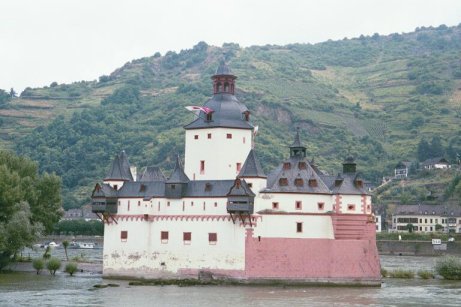 |
|
Rhine Revisited by Gregory E Bandlow
Around the next bend in the river and two more ruins, the ruin Nollig and the
ruin Furstenberg. Then into view came Burg Stahleck at the town of Bacharach.
In the distance, in the middle of the river stood the castle Pfalzgrafenstein
or "Pflaz" for short. I knew now we were getting close. My father had told
me to be on the lookout for the "Pflaz". This was the southern end of the
Eighty-ninth infantry's sector and their southern crossing point. The
"Pflaz" is located in the river just below the city of Kaub. Above the city
of Kaub stands the castle Gutenfels. At last definite confirmation that
we were indeed in the right place. This castle is depicted in historical
context on the preceding page. Burg Gutenfels, like all the other castles
we had seen were constructed for two purposes. To exact duty from merchant ships
traveling along the Rhine and more importantly to defend Germany from invaders.
In 1945 this was the case. The German army had retreated behind the natural
barrier of the Rhine. This was their last ditch stand, the last natural barrier
to the attacking allied armies from penetrating the heart of the Germany.
As we cruised lazily along in the morning sun that was just now beginning to
break through the haze, I explained this story to my daughters Jessica and
Jennifer. Burg Gutenfels last encounter with an invading army was in 1806
when Napoleon had the castle defenses removed. The castle was now going to
again come under siege, this time by an equally determined foe. The Eighty-ninth
infantry. The outcome would be the same for the castle and it's defenders, defeat.
|
